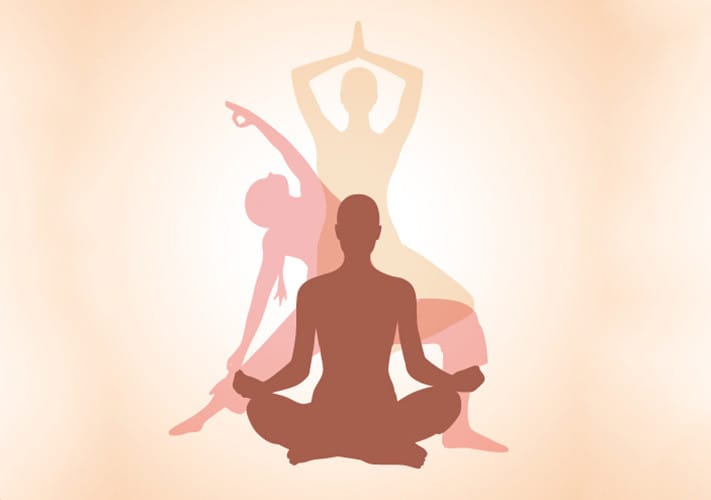In the ancient scriptures of Yoga, particularly in the revered Yoga Sutras of Patanjali, lies the profound wisdom of Ashtanga Yoga – the eightfold path to spiritual realization and inner harmony. As elucidated by Patanjali, Ashtanga Yoga encompasses a systematic framework consisting of eight limbs, each serving as a stepping stone towards the ultimate goal of self-realization. Let’s embark on a journey to explore the essence of Ashtanga Yoga, drawing insights from the Yoga Sutras and delving into the significance of its foundational principles – Yamas and Niyamas.
. The Eight Limbs of Ashtanga Yoga
1. Yamas (Restraints)
The Yamas, as outlined in the Yoga Sutras, are ethical principles that guide our interactions with the external world. Patanjali emphasizes their importance in leading a virtuous life through various sutras. For instance:
**Yoga Sutra 2.30:** “Ahimsa Satya Asteya Brahmacharya Aparigraha Yamaah” – This sutra highlights the five Yamas: Non-violence, Truthfulness, Non-stealing, Moderation, and Non-attachment.
2. Niyamas (Observances)
Similarly, the Niyamas are personal observances that foster self-discipline and inner harmony. Patanjali elaborates on these principles in the Yoga Sutras, emphasizing their significance for spiritual growth. For instance:
**Yoga Sutra 2.32:** “Shauch Santosh Tapah Swadhyay Ishwar Pranidhanani Niyamah” – This sutra enumerates the five Niyamas: Purity, Contentment, Discipline, Self-study, and Surrender to a Higher Power.
3. Asanas (Physical Postures)
Asanas, the physical postures practiced in Yoga, aim to cultivate strength, flexibility, and balance in the body. While Patanjali doesn’t delve deeply into specific postures, he acknowledges their importance in preparing the body for meditation.
**Yoga Sutra 2.46:** “Sthira Sukham Asanam” – This sutra defines Asana as a posture that is steady and comfortable. It suggests that a yogi should find a posture that is both firm and pleasant to practice.
4. Pranayama (Breath Control)
Pranayama involves regulating and controlling the breath to harness the prana (life force energy) within the body. Patanjali mentions Pranayama as a crucial practice for achieving mental clarity and vitality.
**Yoga Sutra 2.49:** “Tasmin sati shvasa prashvasayor gati vicchedah pranayamah” – This sutra describes Pranayama as the control of breath, which stops the movements of inhalation and exhalation.
5. Pratyahara (Withdrawal of the Senses)
Pratyahara entails withdrawing the senses from external distractions and turning the focus inward. It is a precursor to deeper states of meditation and inner awareness.
**Yoga Sutra 2.54:** “Svavisayasanprayoge chittasya svarupe anukarah iva indriyanam pratyaharah” – This sutra explains Pratyahara as the withdrawal of the senses from external objects, resembling a tortoise retracting its limbs into its shell.
6. Dharana (Concentration)
Dharana refers to the practice of concentration, focusing the mind on a single point or object of meditation. Patanjali emphasizes Dharana as a means to cultivate mental stability and clarity.
**Yoga Sutra 3.1:** “Desha bandhah chittasya dharana” – This sutra defines Dharana as the binding of the mind to a single point or region.
7. Dhyana (Meditation)
Dhyana is the state of meditation, characterized by uninterrupted flow of awareness towards the object of meditation. Patanjali highlights Dhyana as a transformative practice leading to inner peace and unity.
**Yoga Sutra 3.2:** “Tatra pratyaya ekatanata dhyanam” – This sutra describes Dhyana as the continuous and unbroken flow of concentration on an object.
8. Samadhi (Union with the Divine)
Samadhi is the culmination of Yoga, representing a state of profound spiritual absorption and union with the divine. Patanjali describes Samadhi as the ultimate goal of Yoga, where the individual ego dissolves, and the practitioner experiences oneness with the universal consciousness.
**Yoga Sutra 3.3:** “Tadevarthamatranirbhasam svarupashunyam iva samadhih” – This sutra elucidates Samadhi as a state of pure awareness, devoid of any distinction between the knower, the knowledge, and the known.
.Conclusion
Ashtanga Yoga, with its eightfold path and foundational principles of Yamas and Niyamas, offers a comprehensive framework for spiritual growth and self-realization. Rooted in the wisdom of the Yoga Sutras, Ashtanga Yoga provides guidance on ethical conduct, personal observances, physical practice, breath control, and meditation. May we embrace the teachings of Ashtanga Yoga and tread the path of self-discovery with sincerity, humility, and reverence.
Vedic Wellness Center invites you to delve deeper into the profound teachings of Ashtanga Yoga and embark on a journey of self-realization and inner transformation.
[Contact : Vedic Wellness Center Mansa devi colony, near dhiman furniture ,Gumaniwala Rishikesh, Uttarakhand.]


